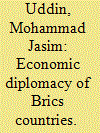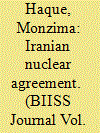| Srl | Item |
| 1 |
ID:
143826


|
|
|
|
|
| Summary/Abstract |
In a modern democratic state, civil society that includes Non Government Organisations (NGOs) is an important governance actor. With increasing demand for policy change as part of governance reforms, governmentNGO-donor collaboration emerged to facilitate the process. Governance of collaboration or collaborative governance has been instrumental in policy changes across countries and sectors. However, the collaborative governance literature predominantly focus on in-country and local cases of “consensusoriented decision making” by multiple stakeholders in wide range of fields. This article attempts to fill the gaps in literature by showing first that collaborative governance can be a tool of policy changes not just day-to-day policy choices, and second, the ‘transnational’ dimension of collaborative governance, in which case foreign or multilateral actors join with local and national actors in decision making - a frequent phenomenon in many countries of the global south that receive development assistance. The article examines the role of collaborative governance in policy change through a case study of the Right to Information (RTI) legal reform in Bangladesh. It adopts the general model of collaborative governance as depicted in Chris Ansell and Alison Gash’s seminal piece ‘Collaborative Governance in Theory and Practice’ to explain government-NGO-donor collaboration over RTI law in Bangladesh.
|
|
|
|
|
|
|
|
|
|
|
|
|
|
|
|
| 2 |
ID:
143828


|
|
|
|
|
| Summary/Abstract |
Divergence of economic diplomacy among the BRICS (Brazil, Russia, India, China and South Africa) countries produces variation in their external economic settings. Bangladesh may not be able to follow the whole of economic diplomacy exercised by BRICS countries. Even a particular country’s entire initiatives may not be fully suitable for Bangladesh. Economic diplomacy of Bangladesh could be benefited from mutual learning and exercising best practices of BRICS countries. Diplomatic networks of Bangladesh’s Ministry of Foreign Affairs (MoFA) need to be attuned with changing global economic diplomacy. Bangladesh should realise that economic diplomacy differs based on competence and skills of diplomats engaged in international economic negotiations. Otherwise, consolidation of Bangladesh’s foreign affairs and its economic promotion would be tricky.
|
|
|
|
|
|
|
|
|
|
|
|
|
|
|
|
| 3 |
ID:
143825


|
|
|
|
|
| Summary/Abstract |
The body of theoretical and empirical literature suggests that economic regionalism is beneficial for trade flows. The fundamental analytical questions are whether the groups demonstrate significant impetus to expand intra-bloc trade and whether trade liberalisation within the regional arrangement results in non-trivial mutual gains. To address these queries, this paper investigates the trading pattern and potential of Bay of Bengal Initiative for Multi-Sectoral Technical and Economic Cooperation (BIMSTEC). It adopts a stochastic trade frontier approach to an augmented panel gravity model. The results reveal that imports of the member countries follow the Linder hypothesis, while exports can be explained by Heckscher-Ohlin-Samuelson theorem. Controlling for behind and beyond the border constraints, the results of a stochastic frontier gravity model also support these findings. Such constraints are found to explain most of the total variation in imports and exports. The results also suggest that the highest trade potential, estimated by the frontier gravity model, turns out to be significant. Also, members of the group can substantially expand intra-BIMSTEC trade if the constraints are either removed or kept at the minimum.
|
|
|
|
|
|
|
|
|
|
|
|
|
|
|
|
| 4 |
ID:
143832


|
|
|
|
|
| Summary/Abstract |
Over the last two and a half years, negotiators from P5+1 and Iran are trying to reach out a diplomatic solution on the issue of nuclearisation of Iran. The motive behind such an arrangement had been to ensure that Iran’s nuclear ambition remains exclusively peaceful in harmony with the international non-proliferation principles. Iran too, wanted to break out from the shackles of sanctions that had limited its global commerce in the past years. With the conclusion of a nuclear agreement in Vienna, it is expected that Iran will not pursue actions to develop nuclear weapons, at least in the immediate future. Nevertheless, implementation of the agreement requires walking down an even more complicated path than negotiation and is considered to have significant implications for the Middle Eastern region. Given this context, this paper makes an attempt to review the nuclear deal being signed and looks into its future implications.
|
|
|
|
|
|
|
|
|
|
|
|
|
|
|
|
| 5 |
ID:
143830


|
|
|
|
|
| Summary/Abstract |
This paper examines the prospect for Sino-Indian maritime cooperation in the context of China’s recent multilateral maritime connectivity project known as the 21 Century Maritime Silk Road. This ambitious step as a part of China’s greater ‘Road and Belt’ initiatives generated considerable trade and infrastructure development prospects for neighbouring countries including India. However, India is highly skeptical and anxious about China’s long term motive and has taken rather an ambivalent position. Geopolitical apprehensions concerning China’s rise and the fear of China’s growing influence in the Indian Ocean made this maritime project an uneasy development for India, despite the initiative’s potential to accord the country tangible economic benefits. In addition, extraregional forces in Indian Ocean geopolitical calculations could complicate India’s maritime cooperation with China. Therefore, the complicacy involves a much broader geopolitical hedging. There is an alignment of interests among India, the US and Japan in preventing China’s deeper and long-term engagement in the Indian Ocean Region. However, economic interdependence, the need for infrastructure development as well as seaward reorientation of Indian economy could drive the country to find out a carefully crafted policy of exploiting economic benefits by engaging with China in the maritime sphere.
|
|
|
|
|
|
|
|
|
|
|
|
|
|
|
|